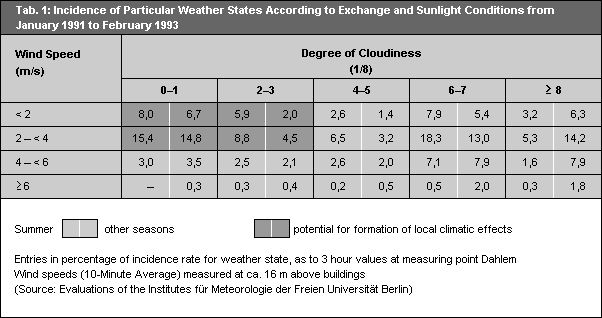Fundamentally a two-peak distribution can be found for each season. One peak represents weather conditions with slight wind speeds and relatively heavy cloudiness. The other peak represents the both climatically as well as air hygienic problematic weather conditions with slight wind speeds and high radiation intensity. In the winter months these weather conditions tend toward low exchange situations with high pollutant content in the atmosphere. In the summer they are caused chiefly through stationary high-pressure areas, in whose course a considerable bioclimatic stress potential can develop locally. In the summers under investigation, these weather conditions appeared in more than 38 % of all observed cases.
Above all against the background of these spatially conditioned problematic weather conditions, climatically favorable and structures with a relief impact are significant. These are on one hand the extensive open spaces near the periphery of the cities with their offshoots reaching in part as far as the city center. Determining for their efficacy are relief relationships, vegetation structures and the density of development in the transition areas between city center and surrounding countryside. Even slightly inclined valleys or ventilation paths, which proceed in the direction of the city, can function climatically and provide air hygienic relief, if these areas are openly structured.
With increasing distance from the outskirts and reduced connection to the climatic equalization areas of the surrounding countryside, small-scale wind systems between inner city open spaces and their direct environment become important. The air masses ascending over the built-up warmed area are replaced by cool air from the adjacent open spaces (plain wind effect). Within the green spaces themselves, a strong decrease in the ventilation is to be expected according to vegetation structure. At low exchange weather conditions the near ground cold air formed there causes an additional stabilization the near ground air layer. Thus the pollution risk to green spaces must be classified as very high. This makes clear that the positive effects of open spaces on the environment can only be fully unfolded if climatic equalization spaces are not burdened by near ground emitters. The spatial expansion of the impact area is determined by the edge development structure.
Investigations and measurements in the Tiergarten illustrate the connections described. The measured temperature differences between the internal area of the Tiergarten and the heavily built-up areas southwesterly and adjacent to the north amount to 7 °C. The broadly laid out streets within this open space lead to a division of the cold island in several parts (Horbert and Kirchgeorg 1980). The elevated city rail (S) and long-distance rail line hinders the exchange of air between the Tiergarten and the environment to the north and northwest. In contrast, at the underpasses in the south and east considerable ranges could be ascertained. To the west, the impact extends along the Straße des 17en Juni to Ernst-Reuter-Platz; then southwest up to the Breitscheidplatz (v. Stülpnagel 1987).
On account of the limited extent of open spaces, measures for the relief of conurbations also in the built-up and condensed areas are necessary. Of considerable importance in this connection is the greening of city places, streets, buildings and courtyards. Overwarming can be decreased so, the moisture level of the air increased and dust bound.
The warming of roofs depends very greatly on their color and their material (cf. Map 04.06, SenStadtUm 1993f). The most favorable conditions are to be found on greened roofs, whereby the kind of the plants plays a large role. However it must be acknowledged that the positive consequence of highly placed roofs on the more greatly burdened street space is limited. Altogether the greening of facades might have a greater climatic impact. Extensive investigations as to the significance of facades and roof greening for the micro-climate were conducted by Bartfelder and Köhler (1987) in Berlin.
The layout and/or the planting of vegetation for courtyard areas is also part of the climatic-air hygiene improvement of the residential area (Horbert, v. Stülpnagel, Welsch 1986, Horbert 1992). Narrow closed courts distinguish themselves through a decrease in the daytime temperatures and a slight cooling in the evening and night hours. The solar illumination is greatly limited. This applies also for the air exchange, from which a high pollution risk emerges. The climatic conditions improves with the greening of these courts, whereby for the advancement of the air exchange a wall greening is more favorable than the planting of trees. Larger court yards reach, in contrast to narrow courts and street space, clearly more favorable climatic characteristics especially, if the degree of sealing is low and the greening loosely structured. The cooling rate in the evening and night hours is high. The air exchange counts as very good. A connection with adjacent smaller courts via empty
sites furthers their ventilation.

